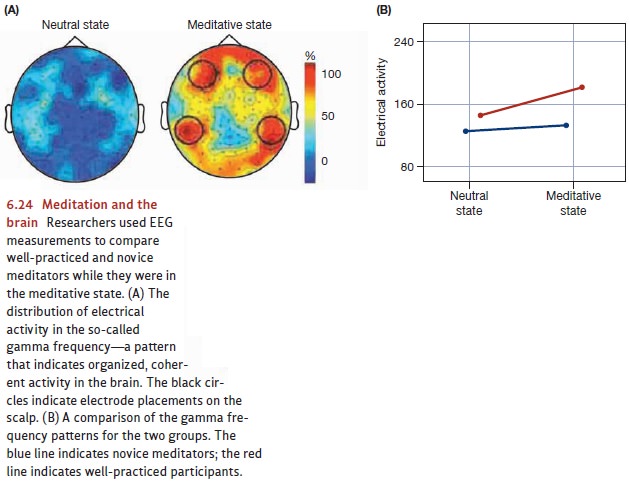Chapter: Psychology: Consciousness
Consciousness: Religious States(Meditation)
Religious
States
Altered states of consciousness
can also be achieved through some religious practices. Of course, religions vary
enormously in their tenets and in their rituals, and that variety is crucial
here. In some religions, worship encourages a state of extraordinary excitement
in which people shake, or fall on the floor, or shout out in “languages” no
human understands. In other religions, worship involves a quiet state that
encourages feelings of reverential awe. In still other religions, worship
involves special circumstances—deep isolation, or periods of fasting, or even
pain—to encourage thoughts about a world filled with supernatural forces
MEDITATION
Perhaps the most-studied
religious state, however, is the one achieved through the religious practice of
focused meditation, during which the meditator focuses on a particular chant or
perhaps just a syllable. Alternatively, in some traditions, the medita-tor
focuses on a visual target such as a candle in the room or a prayer mandala
that is either physically present or called up from memory (Figure 6.23).
Practices like these are common in many Asian religions including Hinduism,
Taoism, and Buddhism.

In all of these religions,
meditators report feeling profoundly relaxed during the meditation exercise and
both unresponsive to most external stimuli and simultaneously highly alert to
certain ideas. Indeed, in many traditions, the meditators strive to shut out
any distracting thoughts while trying to be fully alert to insights that may
arise within the meditation.
Notice, then, that there are
several parallels between the meditative states and hypnosis: Both are quiet,
relaxed states created by close attention to a specific stimulus. In both
states, the person is largely oblivious to many stimuli but highly alert to
other ideas—the hypnotist’s suggestions in the one case and, in the other,
thoughts leading to mindfulness, tranquility, and (in some traditions)
compassion.
MEDITATION AND THE BRAIN
Meditation has many effects on
both mind and body. When compared to nonmeditators, people who meditate seem to
have lower blood pressure, lower levels of the body’s stress hormones, and
enhanced immune response (Barnes, Treiber, & Davis, 2001; Davidson,
Pizzagalli, Nitschke, & Kalin, 2003; Infante et al., 2001). Meditation also
seems to have a powerful impact on brain activity. One study, for example, used
EEGs to assess the brain’s state during meditation; the data showed a strong
increase in the alpha rhythms associated with a state of relaxation (Lutz et
al., 2008).
In another study, the researchers
examined a type of meditation in which the per-son doesn’t focus on any
particular target. The researchers also used measurement techniques that would
be sensitive to faster rhythms in the brain’s activity, and they studied
meditators with a considerable amount of skill—Buddhist practitioners with at
least 10,000 hours of training in meditative practice! In the experiment, the
researchers collected EEG data from these adept practitioners while they were
in a mental state focused on “unconditional loving-kindness and compassion.”
For comparison, the study also included a group of control participants who had
been given a week to practice meditation. During that week, these control
participants were asked at first to think of someone they cared about and to
let their mind be filled by a feeling of love or compassion toward this person;
later, they were encouraged to let their thoughts be filled with similar
feelings toward all sentient beings (Lutz, Greischar, Rawlings, Ricard, &
Davidson, 2004).

The EEG records collected during
meditation showed several differences between the two groups. One finding was
that the brains of well-practiced meditators showed a pattern of neural
activity in which brain areas that were anatomically distant from each other
were nonetheless firing at the same rhythm and in synchrony. The specific
rhythm observed, and the synchrony itself, are both thought to be crucial for
the processes that coordinate and integrate brain activity in distinct areas
(Figure 6.24). The implication, therefore, is that the meditation had created a
strongly unified, cohesive experience—an experience, roughly put, of
“one-ness.” More broadly, this shift in brain activity associated with this
type of meditation is certainly consistent with the idea that the meditation
does produce a change in the quality of the medita-tor’s moment-to-moment
conscious experience.
Related Topics